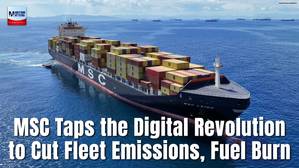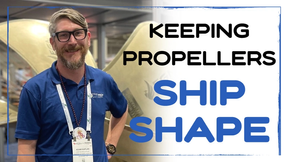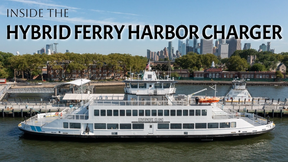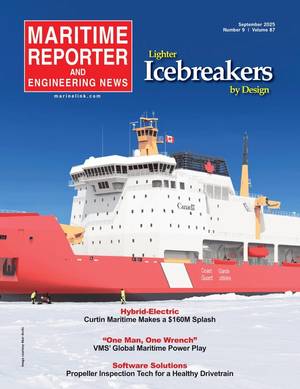BUYING INTO THE FUTURE
U.S. Industry Is Changing To Compete By act of Congress or by act of will, the U.S. shipbuilding industry is making changes to become commercially competitive on the international market. There are myriad factors involved in the trend, including: funding from the government via Technology Reinvestment Project (TRP) or Maritime Administration Title XI guarantees for yard modernization; partnerships with overseas competitors fostering technology transfers; and introductions of new, commercially viable products. The bottom line: suppliers and shipyards are pulling out all stops to efficiently manufacture quality, cost effective ships.
Here's a look at some recent developments. New Designs, As announced in the April edition ofMaritime Reporter, Newport News Shipbuilding (NNS) debuted its design of a product tanker for the commercial market. Dubbed the Double Eagle 333, the ship measures 649 feet (197.8 m) long and 102 feet (31 m) wide, and has a deadweight of approximately42,000 tons (design draft). According to Ed Waryas, director of commercial marketing at NNS, reaction to the new vessel "has been very favorable, we have had a number of serious inquiries domestically and internationally. One design feature that interested potential cusmanaging editor tomers is that the Double Eagle utilizes all mild steel construction." He also said that the shipyard is in the position to sign a contract and start the process now. "We've done a lot of successful, on-time and on-budget ship repairs, and now with the Double Eagle the word is out that we are back in the commercial business," Mr. Waryas said.
While NNS—a yard long in history, experience and reputation— was announcing its commercial offerings, more recently a new shipbuilding venture announced its intentions to build ships in the U.S.
Shipbuilding Ventures, Inc.—formerly U.S. Shipbuilding Consortium, Inc. and a member of the Skaarup Group—made a joint announcement with McDermott Shipbuilding that the new group intends to build product carriers and other ships based on the Skarhar design (please see page 47 of this issue for full details). Perhaps most interesting is that, along with the venture announcement, it was revealed that the Skaarup Group and SVI have signed a letter of intent with the new company— dubbed U.S. Shipbuilding Corporation (USSC)—to build a 40,000-dwt product carrier, with an option for a second.
Automation: Portable Shipbuilding Robotics A TRP grant was awarded to CYBO Robots, which seeks to develop a dual-use portable robot weld- ing system to help improve U.S. shipbuilding productivity. The $12.5 million project will attempt to integrate technical advances in personal computers, robot design, offline programming software, three-dimensional vision and weld sensors to provide a system that meets the unique needs of a shipyard.
The keys to these robots will be their mobility and ability to be automatically programmed, offline, for a one-of-a-kind design. Further, the development team, in its proposal for the TRP funds, estimated that the cost of welding robots will be reduced more than 50 percent, enablingU. S. shipbuilders to purchase robots for less than $25,000. If successful, it is estimated that robots will automate up to 75 percent of ship welding.
To ensure that it will create a marketable product, CYBO Robots has assembled a team of partners and consultants to help every step of the way. According toRon Reeve, CYBO Robots' president, the team basically consists of three member types: commercial members, technology members and marketing members. Four shipyards—Bath Iron Works, Ingalls Shipbuilding, National Steel and Shipbuilding Company (NASSCO) and Trinity Marine Group—are in essence the "marketing committee," Mr. Reeve explained, as each of their input will be used to define the yard's needs and determine if the product is usable. CYBO Robots is no stranger to helping develop productivity-enhancing robotic solutions, as evidenced by its role several years ago in the modernization of the General Dynamics Land Systems Division Lima, Ohio plant, which builds the M1A1 Abrams tanks.
Similarly, Mr. Reeve is no stranger to government-assisted technology programs, and of the ongoing TRP program he said: "I've been in industry a long time, and this is the most exciting government program I have ever seen.
Research and development takes a long time, and getting venture capital (to fund R&D) is tough." But the real benefit, he believes, is the program's focus on commercially viable products. "(With this project) we're not focused on building a product for the government; we are building a product for the commercial market which also fits the government's needs." WEMD Takes Two TRP Awards The Westinghouse Electro-Mechanical Division (WEMD) was the first privately owned design and manufacturing facility devoted exclusively to the production of critical components for nuclear reactors. Formed in 1952, the division is fully owned and operated by the Westinghouse Electric Corporation, in Cheswick, Pa. The initial focus of the facility was to provide reactor main coolant pumps with integral motors for the U.S. Naval Nuclear Propulsion Program. WEMD supplied the main coolant pumps for the world's first nuclear-powered submarine, the U.S.S. Nautilus. ARPA received more than 80 proposals addressing shipbuilding and provided five awards. Of these five awards for the shipbuilding industrial infrastructure category, WEMD received two: Development of the Submerged Electric Cargo Pumping System, and Demonstration of the Integral Motor/Propeller Propulsion system for commercial ships. According to WEMD, a submerged electric drive pump would be a major step forward in liquid cargo handling technology for product tankers and liquid chemical carriers. The critical issue of operational safety has been thoroughly addressed in the design. The WEMD concept has received positive feedback from shipyards, ship operators, maritime architects and consultants. The WEMD Submerged Electric Drive cargo pump would be a direct substitute for either of the currently available technologies: submerged hydraulic pumps or deck-mounted electric deep well pumps. The design was conceived to provide advantages, including: eliminating the hydraulic power supply and high-pressure deck manifold of the submerged hydraulic system, and eliminating the long shaft and multiple bearings of the deck-mounted electrical system.
Foreign Partnerships: importing Technology = Exporting Ships The Maritime Administration has entered into a cooperative agreement with Bath Iron Works (BIW) to develop the capability to construct competitive ships for export. The two-year, $13.9 million project is in essence designed to transfer management and production process technologies to create a globally competitive shipyard. Specifically, technologies to be transferred could include computer-aided design and process simulation, advanced automated fabrication processes, flexible automation/robotics, real time measurement systems for process control, production planning, mate material control and estimating, and pollution abatement. These process technologies, it is maintained, will help improve both production of commercial vessels and warships for the U.S. Navy.
Of the total $13.9 million cost, the government will provide up to $4.5 million, with Bath Iron Works and its partners contributing $5.7 million in cash and $3.7 million in inkind services. Partners in the project include Great American Lines, Inc. and American Automar, Inc. Also participating are Kvaerner Masa- Yards and Mitsui Engineering and Shipbuilding.
The TRP award is just one piece of BIW's attempt to modify technology, modernize facilities and develop human resources to become a competitive commercial shipbuilder, according to Joseph Fortin, director of commercial shipbuilding. According to him, BIW had a five-year plan to commercialize before TRP. The primary goal of the program was, and is, to save jobs and retain a skilled workforce.
The end goal of the five-year plan is to build RoRo-type ships, said Mr. Fortin, a vessel type chosen because of the complexity factor.
"BIW's strength is in our ability to outfit complex ships," he said. The goal at Bath is to be in a position by late 1995 to attract a multi-ship deal. While the final goal is to build commercial vessels, Mr. Fortin claims the yard will maintain ties to the Navy. "Commercial work at Bath Iron Works will not replace Navy work, it will supplement our core business, which is and probably always will be, Navy shipbuilding." Yet he maintains a direct benefit will be the capability to build Navy ships even more efficiently.
It also means that BIW must integrate processes and systems which work best in a dual use—commercial and military—facility.
Phase one of the technology transfer, already completed, involved sending small, cross-functional groups from BIW to the two participating yards to observe. Phase two will entail taking the acquired knowledge from phase one, and sending back specific people to witness specific process technologies.
In BIW's case, the term "technology transfer" does not specifically equate to the purchasing of a piece of equipment, but rather to the transfer of process improvement techniques, leading to executable shipbuilding plans, from market analysis, to design, to a design and construction plan, to facilities modernization.
NASSCO is another shipyard looking overseas, while making facility enhancements, in an attempt to win commercial business. According to Fred Hallett, senior vice president and chief financial officer, the shipyard signed a technology transfer agreement with Kawasaki Heavy Industries Shipbuilding Div. (KHI). The agreement provides for employees from both yards to make visits, in particular looking at layout, accuracy control, equipment and the general processes incorporated to put an orderbook through the facility. He noted that the yards are very similar in many ways, and have been working together informally for the past 10 years, just recently formalizing the relationship with the technology transfer agreement. In essence, NASSCO wants to build "relatively simple, large, ocean-going ships," according to Mr. Hallett—such as tankers, container ships and car carriers. However, Mr. Hallett maintains that "defense conversion" is in fact a misnomer for NASSCO, because of the yard's history of involvement in the commercial market. He refers to it more as a return to a strong commercial base, and maintains that the following areas must be addressed to do so: • Yard Modernization: Must meet the standards to compete on an international level. Ongoing projects include the Ways 2 project, a $5 million project which is the yard's biggest facility upgrade, intended to help perfect its on-block outfitting techniques. The company hopes to use MarAd Title XI funds here. • Technology Update: NASSCO believes its relationship with KHI can help it "leap frog" up to the technology level it desires.
• Market Access: Simply put, the creation of a level playing field (i.e. subsidy elimination), and in the event that never comes to fruition, teaming with foreign competitors. On the subject of subsidies, Mr. Hallett is doubtful that they will ever be eliminated: "If I was a foreign government and you were asking me to give up jobs, why would I do it?" For skeptics who doubt the ability of U.S. shipbuilders to become competitive on the international level, Mr. Hallett suggests that the state of the U.S. steel industry years ago serves as a strong example to the contrary. "Ten to 15 years ago the U.S. steel industry was written off as old and non-competitive. There was a structure put in place to allow them to compete, and today's costper- ton is competitive worldwide."









